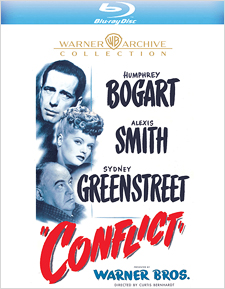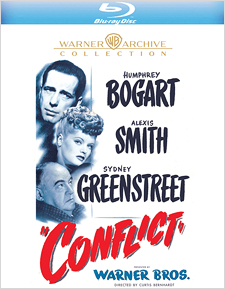Conflict (Blu-ray Review)

Director
Curtis BernhardtRelease Date(s)
1945 (September 24, 2024)Studio(s)
Warner Bros. (Warner Archive Collection)- Film/Program Grade: B-
- Video Grade: A
- Audio Grade: A
- Extras Grade: B
Review
Conflict, a psychological drama with film noir elements, focuses on a man who commits a murder and is subsequently consumed by self-doubt, guilt and fear. With a suspenseful script and an expressionistic style, it’s an unusual crime drama.
Richard Mason (Humphrey Bogart, High Sierra) and his wife Kathryn (Rose Hobart, Dr. Jekyll and Mr. Hyde) are about to celebrate their fifth wedding anniversary. Publicly, they present themselves as a happy couple, but the marriage is not at all ideal. Richard has fallen in love with Kathryn’s younger sister, Evelyn (Alexis Smith, Hollywood Canteen). Kathryn, suspecting this for some time, confronts her husband but tells him in no uncertain terms that divorce isn’t an option.
Their old friend, psychologist Mark Hamilton (Sydney Greenstreet, The Maltese Falcon) is hosting a dinner to celebrate their anniversary. He has also invited Evelyn and his colleague Norman Holdsworth (Charles Drake, Harvey), hoping the two young people will be attracted to one another. Driving home in a downpour that night with Kathryn and Evelyn, Richard has an accident on the road. The women are unhurt but Richard suffers a badly broken leg and must be in a wheelchair until his leg fully heals. The long confinement gives him time to think about how to free himself. By the time he’s able to walk again, he conceals the fact.
Richard has devised a foolproof plan to murder Kathryn. On the night she drives off to visit a friend, he will ambush her on the road. For an unassailable alibi, he will make sure a work colleague and a servant see him at home, wheelchair-bound and worried that his wife hasn’t yet phoned him from her destination. His plan appears to be working until curious signs suggest that Kathryn might not be dead.
Director Curtis Bernhardt creates escalating tension as Richard becomes increasingly unhinged as he sees ever more evidence, which neither the police nor his friends seem to have perceived, that his wife is alive. Is he imagining these signs or is Kathryn actually alive? Bernhardt uses subjective shots to let us see what Richard is seeing and close-ups to show his reactions. Because we never actually see Richard kill Kathryn, we don’t know how he killed her. We only see the aftermath, an elaborate scheme to suggest her car ran off a narrow mountain road.
Bogart, who had risen to a new level of stardom with The Maltese Falcon five years earlier, is in fine form in Conflict. He’s thoroughly convincing as his Richard spirals from repressed anger under a placid facade, to fury sufficient to fuel a murder plot, to an almost smug belief that he has committed the perfect crime, to the increasing shiftiness as he plays the grieving widower while his fears increase.
Richard’s wife and her sister are no more than plot points, their characters so undeveloped that Hobart and Smith have little on which to build an affecting performance. But Greenstreet has a meaty role as the jovial, unsuspecting psychologist who later becomes key to figuring out what really happened to Kathryn. With a strong screen presence, Greenstreet makes an imposing, self-confident figure. His performance and Bogart’s greatly elevate the stature of the film.
A significant part of the film relies on the odd appearances of Kathryn’s possessions, placement of objects, and even a sighting of the supposedly dead Kathryn creating self-doubt in Richard. The climactic explanation tying these events together seems unlikely and would involve impossible timing, carefully placed individuals, masters of deception, and a pretty obtuse Richard, adding up to a far-fetched plan to entrap the murderer.
Conflict was shot by director of photography Merritt B. Gerstad on 35 mm black & white film with spherical lenses, finished photochemically, and presented in the Academy aspect ratio of 1.37:1. Clarity and contrast on the Blu-ray from Warner Archive are sharp, with details such as decor in the Mason’s bedroom, trees and shrubbery on the mountain road, Richard’s trench coat, and the women’s dresses nicely delineated. Shadows and many night scenes give the film a distinctive noir flavor. Scenes on a narrow mountain road and shots of its snake-like path without guard rails indicate its potential danger. When Kathryn’s car is blocked on that road, a deeply shadowed Richard emerges from the shadows to confront her.
The soundtrack is English 2.0 Mono DTS-HD Master Audio. Optional subtitles are included in English SDH. Dialogue is clear and distinct. Sound effects include a heavy downpour, a car making its way on the mountain road, and the same car cascading down a cliff followed by a pile of rolling logs. Friedrich Hollaender’s score has a nice noir feel as it accentuates Richard’s growing concerns that Kathryn might be alive.
Bonus materials on the Blu-ray release from the Warner Archive Collection include the following:
- Life with Feathers (7:42)
- Trap Happy Porky (6:52)
- Peeks at Hollywood (8:56)
- Are Animals Actors? (14:11)
- Theater of Romance (24:50)
- Theatrical trailer (2:03)
Life with Feathers – In this 1945 Merrie Melodies Technicolor cartoon, a lovebird is depressed because his mate no longer loves him and tries to force Sylvester to eat him. But Sylvester thinks there’s something strange about the situation, thinks the bird is poisoned and refuses to eat it. The bird makes various attempts to have Sylvester eat him, with comical results. Voice characterizations are provided by Mel Blanc.
Trip Happy Porky – Porky Pig can’t sleep because mice destroy his dinner plates. Porky’s efforts to get them out of his house repeatedly fail. A cat offers to help and succeeds in shooing the mice away, but invites some drunken friends in while he plays the piano, making things noisier than before, so Porky tries to get rid of the cats but finds they’re more than a match for him. This 1945 Technicolor Looney Tunes cartoon was directed by Chuck Jones.
Peeks at Hollywood – Two pretty starlets are at the Griffith Observatory overlooking Los Angeles. They look through a telescope at Graumann’s Chinese Theater, Ken Murray as artist Salvatore Murray, actor Arthur Lake (Dagwood in the Blondie movies), radios’ The Great Gildersleeve (Harold Peary), the Earl Carroll Theater and Restaurant, actresses Virginia Weidler and Jane Withers, the Warner Bros. Burbank studio, and Errol Flynn. An off-screen narrator identifies celebrities and L.A. places.
Are Animals Actors? – Daisy, a movie dog, is shown doing tricks. With sound film recording, she cannot be given vocal commands, so her trainer uses hand gestures instead. Other trained animals, such as bears, miniature horses, tigers, seals, and monkeys are shown performing their specialties.
Theater of Romance – A September 11, 1945 radio broadcast, presents an adaptation of Conflict, starring Humphrey Bogart. An announcer says that the show is “brought to you” by Colgate tooth powder and Halo shampoo. Atmospheric music and sound effects accompany the dialogue.
Despite its flaws, Conflict is worth watching for Bogart’s performance. The screenplay by Robert Siodmak and Alfred Newman establishes the relationship between Richard and Kathryn early on, but Evelyn is merely the linchpin on which the plot hinges, not a fully fleshed-out character. Charles Drake’s Norman is marginal to the story as a potential romantic interest for Evelyn. Sydney Greenstreet plays a colorful character whose profession figures significantly in the plot. Much of the film feels overly contrived. Bogart would star two years later in The Two Mrs. Carrolls, another film about a wife’s murder.
- Dennis Seuling

